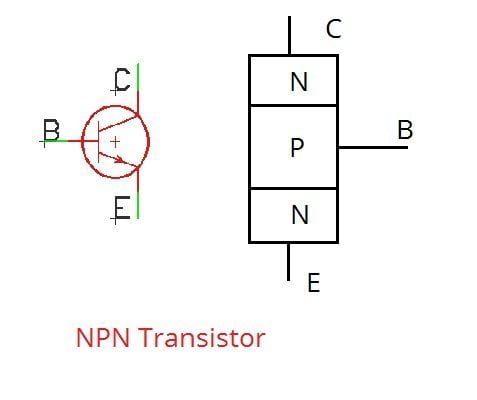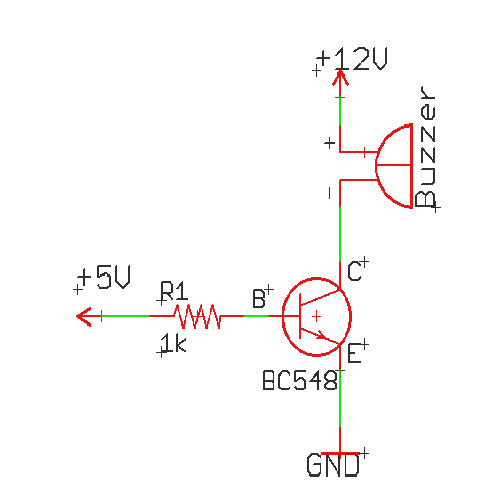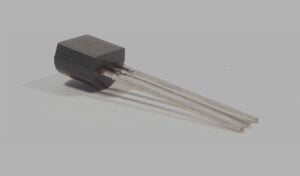Transistor is perhaps the most important of electronic components because of which all modern electronics works. Therefore It becomes not only important but also mandatory to know what is transistor and how transistor works. A transistor is a semiconductor device commonly used to amplify or switch electronic signals. It’s a Device with three terminals where one terminal can be use to control the flow of current through the other two terminals. The three terminals are Emitter, Base and Collector. Its major use is as amplifier to boost various signals as well as to perform automatic switching.
3 Major applications of transistors are
- As a switch
- As Amplifier
- As oscillator
In this tutorial, we’ll see how to use transistor as switch
There are 2 types of bipolar transistors which we primarily use, in general applications.
NPN

When base of n-p-n is connected with logic high voltage (positive voltage) then it short circuits emitter and collector (SWITCH ON). When base of n-p-n is connected with logic low voltage (Ground of Supply) then it open circuits both emitter and collector (SWITCH OFF).

NPN Transistor as switch ( Collector to GND, load connected across Voltage and Collector Terminal)
and base is to be given with a current limited +5v signal to turn on the device
when Base is connected to 0 or GND, the device turns off
PNP

When base of p-n-p is connected with logic high voltage then it opens circuit’s emitter and collector (SWITCH OFF). When base of p-n-p is connected with logic low voltage then it short circuits both emitter and collector (SWITCH ON).
Another point you should keep in mind is that the arrow always points in the direction of positive charge flow, or from the P to N sections, no matter whether the P section is the emitter or base.
Notation aside, the three pins – base, emitter, collector – are typically labeled on the data sheet for a transistor
NPN Transistor as a Switch
As said, the biggest application of transistor is to use it as a switch. We’ll see how we can use the NPN transistor as switch
- Device power to whatever power source I want to use
- Device ground to the collector on my NPN transistor
-
Transistor emitter to “real” ground.
Connection for PNP transistor

Example of Transistor with Buzzer
When interfacing buzzer with micro controller, we often need a large buzzer to generate tones. In such cases, the buzzer can not be directly interfaced to arduino pins. Some buzzer’s will generate loud sounds with 12v or higher voltage. To interface such buzzer with arduino or raspberry pi, we use transistor a switch to interface buzzer with microcontroller. Below is the circuit of how to use transistoized buzzer with controllers.

Commonly used Transistors and their pin identifications
BC548/BC547 :– NPN

BC557 :– PNP

2N3904 :– NPN

SL100:– NPN

This tutorial is for those who are doing embedded applications and want to study how to interface high power DC devices with controller or raspberry pi.
Remember, the current rating of transistor is also to be taken into consideration while designing your circuit. If your load takes about 2 ampere of current, then don’t choose BC547, simply see of an NPN transistor which has collector current rating above 2 ampere and so on.
Lastly not to mention, transistors can only be used to SWITCH DC loads
For anything that involves AC load, transistors shouldn’t be used directly to switch on AC appliances. For simple reason that transistors can’t handle AC because they’re Active devices. And secondly, its not meant to be operated on such high voltages, it’ll burn immediately. So I hope you got a little idea abotu what is transistor and how you can start using it in your projects. Do let me know if you need any additions to this short tutorial.



I have gone through your article it is pretty good and easy to understand ,just one thing there is same diagrammatic example is shown for NPN transistor as switch and PNP transistor as switch it may be confusing for readers.
How’s the “NPN Transistor as switch” diagram different from the “PNP transistor as switch” diagram? They look identical.
You’re right, its some sort of mistake happened on page 🙁
checking it